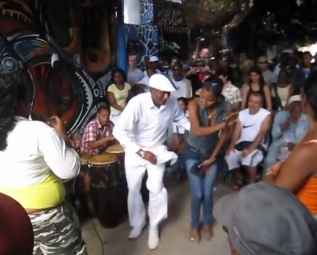Nead to know about Rumba Cubana

- Do not mistake it for tournament rumba, as Rumba cubana and tournament rumba (social) are two different dances with different music.
- In tournament rumba, the music is romantic, usually slow and the partners are in close contact, as opposed to rumba cubana, where the music is fast and lively and the partners are not in direct contact.
- Rumba cubana originated in Cuba, from African slaves' rhythms connected with music of Spanish settlers. It developed on the outskirts of the cities like Havana and Mantanzas, where, after the abolishing of slavery in Cube in 1886, lived so called solares (slums) communities, comprised of very poor African tribes.
- These communities gave birth to the term "rumba" as common fun and joy and "rumbero" describing a person having fun (party-goer)
- the people living in solares were extremely poor, thus the instruments they were playing on were of poor quality. They were using old tubs and pans to drum the rhythm, hitting it with spoons and other household utensils.
- They were also using old boxes (cajones) and that is where the term "Rumba de Cajon" originates from. These bands were accompanied by a person drumming the clave rythm using sticks. In time the boxes were replaced with drum sets - three drums where each of them has its own part to play in the polyrythmic music
- In every rumba there are three music stages:
1. soloist is singing syllables, creating adequate atmosphere. Then the soloist improvises, presenting the rumba main theme and provides a phrase for the choral section which the choir takes on later in the song
2. then comes in the orchestra, which typically comprises of conga, clavo and the drums
3. the solo dancer or a couple comes in front of the musicians and starts the dance. Then the choir, usually men, starts to sing the choral , as a background to the improvising soloist. That is how true "Rompeal rumba" begins.
- Rumba cubana is a dance, percussion, and song - a kind of musical spectacle.
- Rumba cubana comprises of 3 main streams
1. Yambu - the oldest and the slowest style, where the dancers play the parts of elder people. It is called the "old people's rumba". It can be performed solo, by women and men, as well as in couples.
2. Guaguaanc?? �?? with complicated rhythm, danced in couples. The dance symbolises a flirting couple, where man is trying to get his partner, and she is refusing his advances or accepting them.
3. Columbia - it is a traditional male dance with complicated rhythm and the fastest pace , where men dance solo or compete with each other, showing off with their dexterity, strength, confidence and their sense of humour. Recently, elements of hip hop and break dance have been incorporated into Columbia.
- The posture of Rumba cubana is characterised by slight lean forward, bent knees and soft moves
- Rumba is danced on the streets, in the yards and restaurants. All the informal meetings and social gatherings in Cuba are full of traditional, spontainous and joyful rumba.
0 Responses to “Rumba Cubana”
Leave a reply